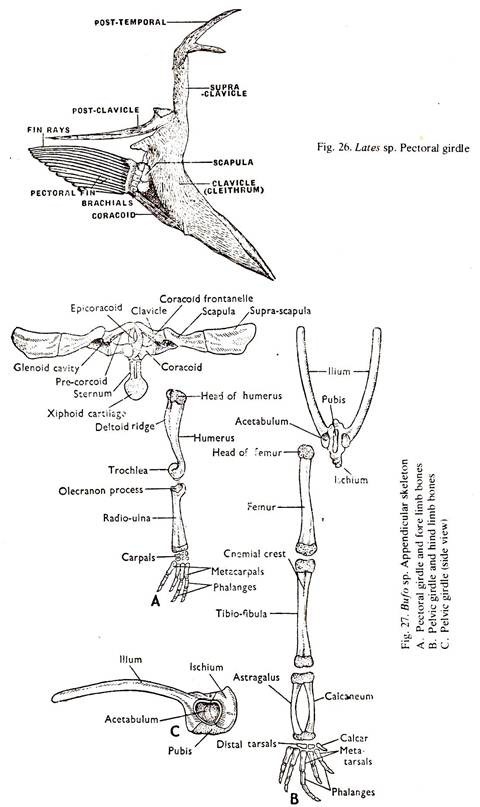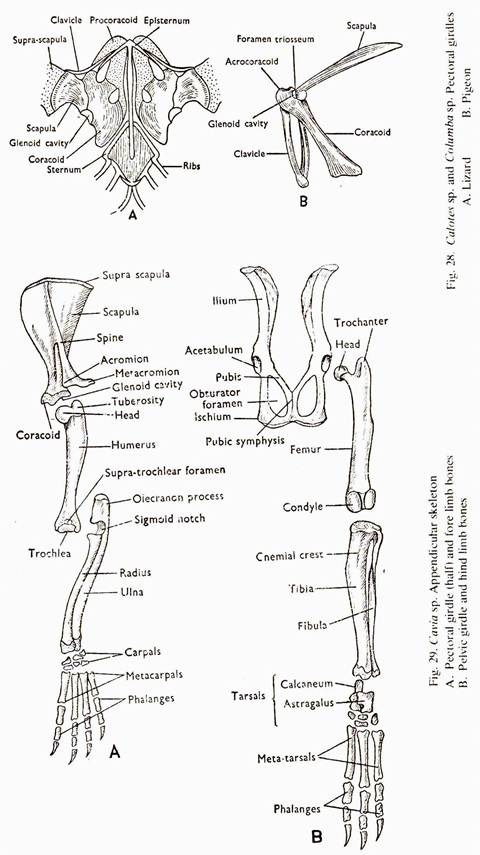Learn about the comparison of pectoral girdles in various vertebrates.
Comparison: Vertebrate # Lates:
1. The pectoral girdle consists of several bones, which support the pectoral fins and is articulated with the skull dorsally. Both the halves are identical and they remain separate.
2. Each half of the girdle consists of
(b) Scapula – A poorly developed bone articulating with the inner margin of the calvicle.
ADVERTISEMENTS:
(c) Coracoid – A poorly developed bone articulating with the inner margin of the clavicle.
(d) Clavicle – It is well developed and ventrally placed.
(i) Supraclavicle – It is attached dorsally to the calvicel and articulates with the skull by a forked postemporal.
(ii) Postclavicle – It is rod-like and passes abackward from the clavicle.
ADVERTISEMENTS:
(e) Somactids – These are small bony pieces which remain placed behind the coracoid and support the dermotricha or fin rays of the pectoral fin.
Comparison: Vertebrate # Bufo:
1. The pectoral girdle consists of several bones which support the fore limbs. Both the halves are identical and they meet at their ventral margins. The sternum and xiphisternum are unpaired structure placed at the midventral line.
2. Each half of the girdle consists of
(a) Suprascapula – A broad partly cartilaginous plate attached to the outer end of the scapula.
ADVERTISEMENTS:
(b) Scapula – A thick plate-like bone broader at the outer end and narrower at the inner end. It takes part in the formation of the glenoid cavity.
(c) Coracoid – It is a short, stout and flat bone attached to the scapula and runs parallel to the clavicle.
(i) Precoracoid – It is a narrow strip of cartilage in front of the coracoid.
(ii) Epicoracoid – It is an axe-shaped cartilage at the inner border of coracoid. Formed by the fusion of the strnal ends of the scapula and coracoid.
(d) Clavicle – It is a slender transverse bony bar articulated with the scapula and epicoracoid.
(e) Sternum – A cartilaginous plate, the sternum extends backwards from the posterior region of the epcicoracoid. The most anterior portion is the bony rod-like sstructure, known as the omosternum. The epicoracoid cartilage represents the middle portion of the sternum. The next portion that is joined to the epicoracoid is he mesosternum, which bears a broad, flate palte, the xiphoid cartilage, at the hinder end.
(f) Glenoid cavity – It is a cavity at the junction of the coracoid and scapula. Into it fits the head of the humerus.
Comparison: Vertebrate # Calotes:
1. The pectoral girdle consists of several bones, which support the fore limbs. Both the halves are identical except the median episternum and sternum. The two halves meet along the midventral line.
2. Each half of the girdle consists of:
ADVERTISEMENTS:
(a) Suprascapula – It is a thin plate of partly calcified cartilage attached to the dorsal end of the scapula.
(b) Scapula – It is a short bone attached to the outer end of the coracoid.
(c) Coracoid – It is a flat bone and articulates with the sternum.
(i) Procoracoid – It forms the anterior portion of the coracoid round the fenestra.
(ii) Epicoracoid – It is a cartilaginous element at the inner side of the procoracoid and coracoid round the fenestra.
(d) Clavicle – It is a flat, curved bone and joins medially with cross piece of the episternum (interclavicle) and laterally with the scapula.
(i) Episternum (Interclavicel) – It is a cross-shaped bone with a longitudinal stem and an anterior small corss piece.
(e) Sternum – It is a rectangular bone situated at the middle and bears ribs at the posterolateral margins.
(f) Glenoid cavity – It is a cavity at the junction of the coracoid and scapula. Into it fits the head of the humerus.
Comparison: Vertebrate # Columba:
1. The pectoral girdle is pushed back to the central region of the body and is completely ossified. Its consists of several bones which support the fore limbs. Bothe the halves are identical and the clavicles of the two sides fuse at their ventral ends to form the furcula.
2. Each half of the girdle consist of
(b) Scapula – It is a flat sabre-shaped bone extending dorsally over the ribs and articulates anteriorly with the coracoid.
(c) Corcacoid – It is a strong pillar-like bone. It fits into the deep groove on the sternum and its upper end joins the scapula by ligaments.
(d) Clavicle – It is a slender rod-like bone, the upper end of which meets the junction of the coracoid and scapula and the other ends of the two clavicles fuse at the middle line and is connected with the sternum by a very small interclavicle.
The fork-like structure formed by the two clavicles is known as ‘wish-bone’ or furcula.
(e) Sternum – It is a separate piece of bone and bears a keel along its midventral lineinto which muscles of flight are inserted it bears ribs at the lateral margins.
(f) Glenoid cavity – It is a cavity at the junction of the coracoid an scapula into which the head of the humersus fits.
(g) Foramen triosseum – It is a small space at the junction of the coracoid, scapula and clavicle through which the tendon of the pectoralis minor runs to be inserted into the humerus.
Comparison: Vertebrate # Cavia:
1. Each half of the pectoral girdle is completely separate structure and consists of several bones, which support the fore limb of the side. The sternum and the xiphisternum form a separated piece of bone, not connected with the two halves of the girdle.
2. Each half of the girdle consists of
(a) Suprascpula – It is a thin, narrow strip of cartilage at the broad, upper end of the scapula.
(b) Scapual – It is a thin triangular bony plate with a narrow neck. The scapula bears a dorsal ridge, which is provided with acromion and metacromion processes. The scapula is highly developed while the clavicle and the coracoids are reduced.
(c) Coracoid – It is a knob-like bone at the narrow end of the scapula and bears a curved coracoid process.
(d) Clavicle – It is an imperfectly developed bone.
(e) Sternum – It is a separate piece of bone and consists of six segments. The first segment or manubrium sterni is narrow, while the other five are large and the last one bears a xiphoid cartilage. The sternum bears ribs at the lateral margins.
(f) Glenoid cavity – It is a concave facet at the narrow end of the scapula, into which fits the head of the humerus.

